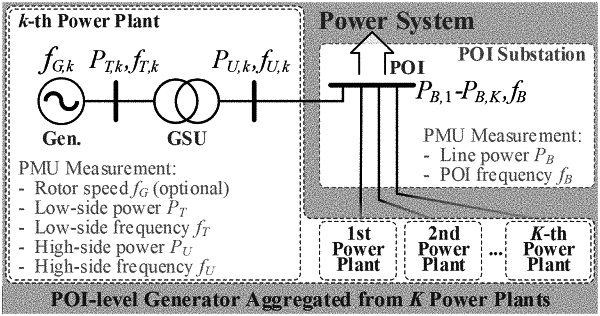| CPC H02J 3/381 (2013.01) [H02J 2300/28 (2020.01)] | 1 Claim |

|
1. A method for maintaining power system stability comprising:
collecting system topology data, reactance values and resistance values of transmission lines from an SCADA/EMS system;
collecting frequency and active power samples from phaser measurement units (PMU) installed at point of interconnection (POI) buses;
calculating active power PT at an POI-level aggregated generator terminal and the rotor speed fG of the POI-level aggregated generator according to the following:
 where A∈
 M×M is a linear correlation between rotor speeds and POI bus frequencies; and M×M is a linear correlation between rotor speeds and POI bus frequencies; andPT=PB,me+diag(r)IB,me2, (22)
where IB,me∈
 M×1 and PB,me∈ M×1 and PB,me∈ M×1 are the current and active power of the incoming line measured by the POI-bus PMU, respectively, and diag(r)∈ M×1 are the current and active power of the incoming line measured by the POI-bus PMU, respectively, and diag(r)∈ M×M is a diagonal matrix; M×M is a diagonal matrix;if the frequency of POI PMU is not available, adopting (19) under an adjusted PMU combination;
if the non-POI PMUs data are available, calculating the following and obtaining the weighted-least-squares solution fG,W:
 estimating POI-level aggregated inertia by solving the following for each POI bus:
2Ĥagpy(t)=ΔPmu1(t)+u2(t), (23a)
y={0,fG(t2)−fG(t1),fG(t3)−fG(t1), . . . ,fG(tK)−fG(t1)}, (23b)
ū1={1,1,1, . . . ,1}, (23c)
ū2={0,−PT(t2)+PT(t1),−PT(t3)+PT(t1), . . . ,−PT(tK)+PT(t1)}. (23d)
in which {Ĥag, ΔPm} is the parameter vector to be identified; y(t) and u2(t) are the values of rotor speed and active power deviation from the operating point,
respectively; and u1(t) represents the mechanical power and remains constant;
estimating the system-level inertia by:
 where Ĥag,i and Sag,i are the POI-level aggregated inertia constant and rated capacity of generator i, respectively;
estimating frequency stability indexes including post-disturbance rate of change of frequency (RoCoF) and frequency nadir based on the system-level inertia;
determine whether the frequency stability indexes reach a predetermined limitation;
when the predetermined limitation is reached, activate at least one generator to increase system inertia.
|